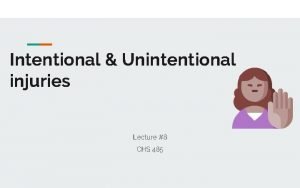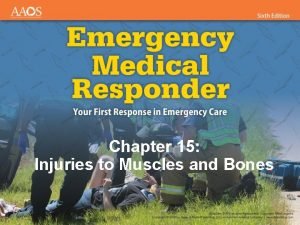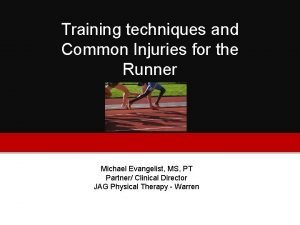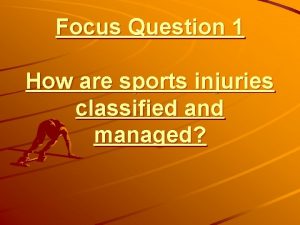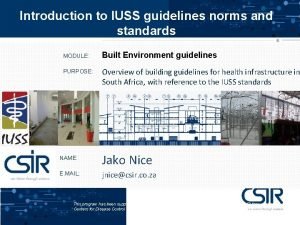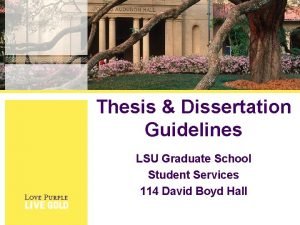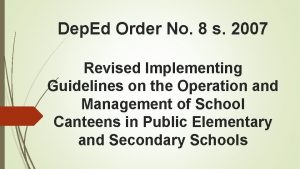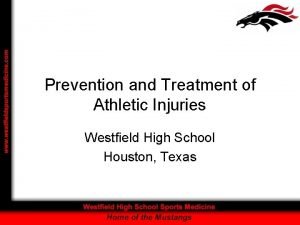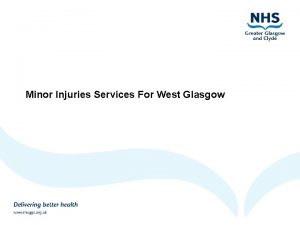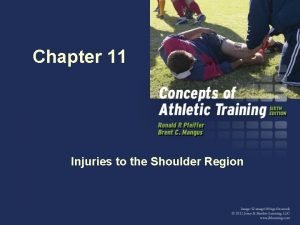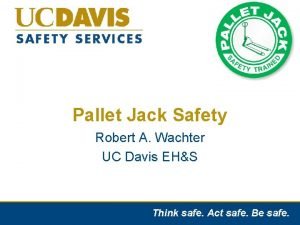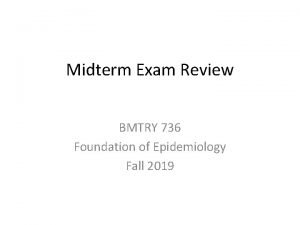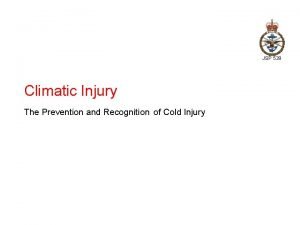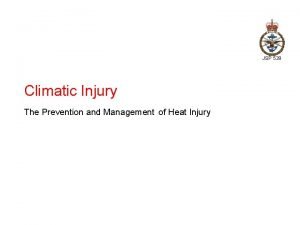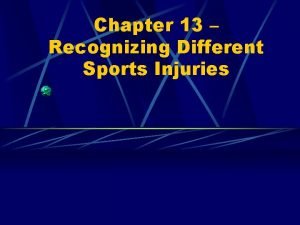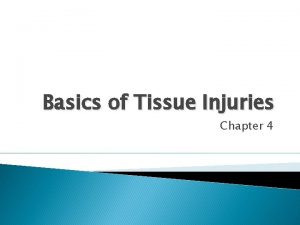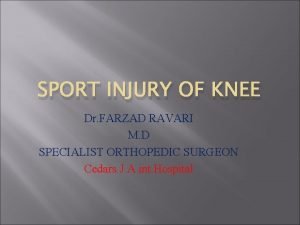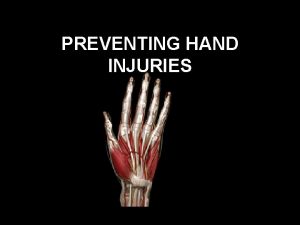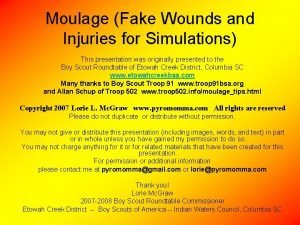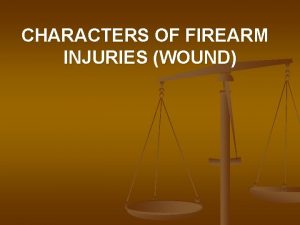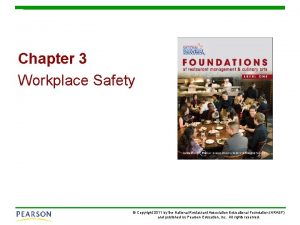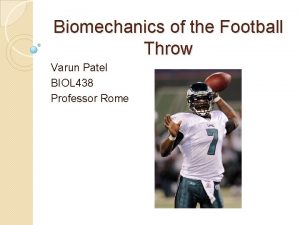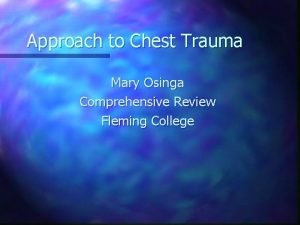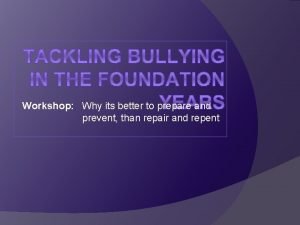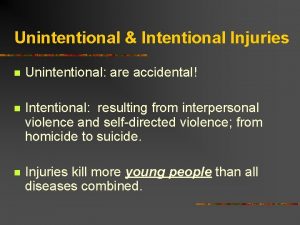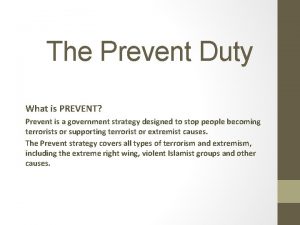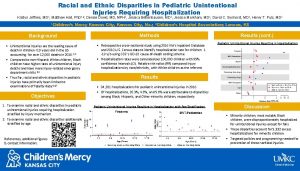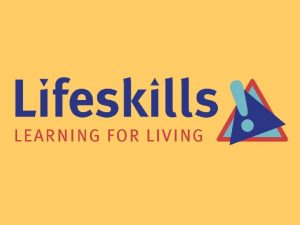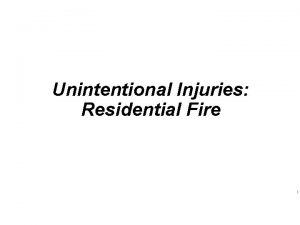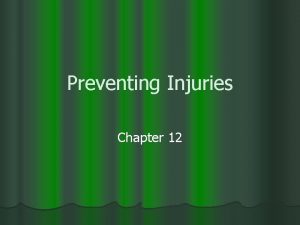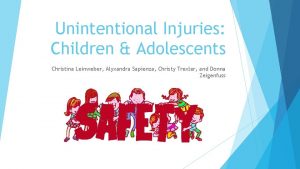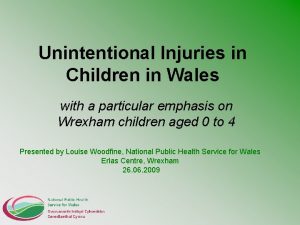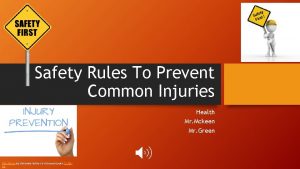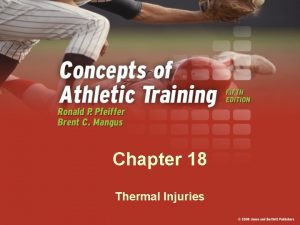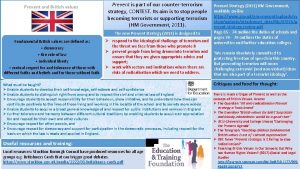School Health Guidelines to Prevent Unintentional Injuries and


























































- Slides: 58

School Health Guidelines to Prevent Unintentional Injuries and Violence


Injuries Kill More Children and Adolescents Than All Diseases Combined Source: CDC, 2000 Vital Statistics

The Injury Pyramid 1 death 41 hospitalizations 1, 100 emergency department visits • 5. 5 million annual visits to emergency departments (children aged 5 -14). • 20 million children and adolescents/year have injuries requiring medical attention or restricted activity; $17 billion/year in medical costs.

Adolescent Violence • From 1990 to 1998, the adolescent homicide rate dropped 28%. • The U. S. child homicide rate (2. 6/100, 000) is 5 times that of 25 other industrialized nations combined. • Among adolescents aged 16 to 19 in 1995: – 1 in 10 was a victim of violent crime. – >100, 000 were arrested for violent crimes. – 2, 944 were homicide victims.

Suicide • More than 1, 700 adolescents aged 15 -19 complete suicide each year. • In 2001: – – 19% of high school students considered suicide. 15% made a suicide plan. 9% attempted suicide. 3% made an attempt requiring medical attention.

Percentage of US High School Students Involved in Violence-Related Behaviors, 2001 Behavior Carried a weapon* Carried a gun* In a physical fight** % of Students 17. 4 5. 7 33. 2 *In the 30 days before the survey. **In the 12 months before the survey. Source: CDC, National Youth Risk Behavior Survey

Percentage of US High School Students Engaging in Unsafe Behaviors, 2001 Behavior % of Students Rarely or never wore seatbelts Rarely or never wore bicycle helmets* Rode with driver who had been drinking alcohol** Drove after drinking alcohol** *Among students who rode bicycles in the 12 months before survey. **In the 30 days before the survey. Source: CDC, National Youth Risk Behavior Survey 14. 1 84. 7 30. 7 13. 3

Injuries Occur Everywhere

Why Focus on School? Schools are Places of Living and Learning

Injuries and Violence in the School Environment • 80% of elementary school students visit a school nurse for injury in a 2 year period. • 10 -25% of child and adolescent injuries occur at school: – 4 million school injury victims per year. • School-associated injuries resulting in hospitalization: – Falls (43%). – Sports activities (34%). – Assaults (10%).

Injuries and Violence in School • Most school injuries are minor: – 6% of EMS incidents. – 1 in 400 injury fatalities.

High School Students Who Felt too Unsafe to Go to School, U. S. , 1993 -2001 Source: Youth Risk Behavior Survey, CDC

Violent Deaths Among School-Aged Children, 1994 -1999

What Are Schools Doing to Prevent Injuries and Violence?

Percentage of Schools with Specific Safety Policies, by Level Type of Policy Elementary Middle/JHS Sr. High Hall monitors 70% 77% 82% Bathroom monitors 60% 57% 59% Check bags, lockers 18% 38% 45% Uniformed police 6% 19% 30% Surveillance cameras 12% 21% 24% Require uniforms 21% 28% 10% Metal detectors 3% 10% Source: CDC, School Health Policies and Programs Study, 2000

School Policies: Unintentional Injury • More than 94% of schools inspect and maintain: – – – Fire extinguishers. Athletic facilities and equipment. Halls, stairs, and regular classrooms. Kitchen facilities and equipment. Playground facilities and equipment. School buses. Source: CDC, School Health Policies and Programs Study, 2000

School Policies: Unintentional Injury • 85% of schools inspect and maintain smoke detectors. • 81% of schools inspect and maintain chemistry labs, workshops, and art rooms. Source: CDC, School Health Policies and Programs Study, 2000

Percentage of Schools Requiring Unintentional Injury, Violence and Suicide Prevention Education, by School Level Source: CDC, School Health Policies and Programs Study, 2000

Health Education • Median hours teaching violence prevention: – 4 -5 hours/year. • Median hours teaching unintentional injury prevention: – 4 -5 hours/year. Source: CDC, School Health Policies and Programs Study, 2000

Percentage of Schools Teaching Skills Related to Violence and Suicide Prevention in at Least One Required Class or Course • Techniques to avoid interpersonal conflicts/fights: 95%. • Anger management: 92%. • Handling stress in healthy ways: 88%. • Dating violence: 62%. • Sexual assault: 61%. • Recognizing stressors/signs of depression: 42%. • What to do if someone is thinking about suicide: 38%. Source: CDC, School Health Policies and Programs Study, 2000

Percentage of Schools Teaching Topics Related to Unintentional Injury Prevention in at Least One Required Class or Course • Protective equipment (biking, skating, sports): 86%. • Fire safety: 84%. • Road/transportation safety: 80%. • Water safety: 66%. • First aid/ CPR: 56%. Source: CDC, School Health Policies and Programs Study, 2000

How Were the Guidelines Developed?

Guidelines Development Process • Literature review. • Expert panel: • • Is there appropriate evidence? How effective is the strategy? (effect size) How feasible is the strategy? What priority should the strategy be assigned? • Agency and organization review. • Revision. • MMWR publication. • Dissemination and diffusion.

The Breadth of the Guidelines Unintentional injury Violence Suicide Social environment Physical environment Health education Physical education Family/community Staff development Health services Crisis response y ho ol HS H ig h sc /J dl e M id e El m en r ta

Coordinated School Health Programs Health education Family/community involvement Physical education Health services Health promotion for staff Nutrition services Healthy school environment Counseling, psychological, & social services

Recommendations to Prevent Unintentional Injuries, Violence, and Suicide 1. 2. 3. 4. Social environment Physical environment Health education Physical education and physical activity programs 5. Health services 6. Crisis response 7. Family and community involvement 8. Staff development

(1) Establish a Social Environment that Promotes Safety and Prevents Unintentional Injuries and Violence • Ensure high academic standards: – Provide administrative leadership to promote the academic success of all students. – Establish a strong academic mission statement. – Establish academic support mechanisms. – Provide opportunities for students to experience success.

(1) Establish a Social Environment that Promotes Safety and Prevents Unintentional Injuries and Violence • Encourage connection to school: – Develop prosocial norms (disapprove of bullying, promote helpful acts). – Involve faculty, staff, students, families, and community members in all aspects of school management.

(1) Establish a Social Environment that Promotes Safety and Prevents Unintentional Injuries and Violence • Develop, implement, and enforce written policies: – Support nonviolence and protect all from harassment, violence, or discrimination. – Emphasize positive behaviors expected of students. – Explicitly state, communicate, and implement consequences of policy violations.

(1) Establish a Social Environment that Promotes Safety and Prevents Unintentional Injuries and Violence • Designate a person to coordinate safety activities. • Have a school safety committee or school health council address safety issues. • Regularly assess programs and policies.

(1) Establish a Social Environment that Promotes Safety and Prevents Unintentional Injuries and Violence • Integrate prevention of unintentional injuries and violence in: – Academic classes. – Employment certificates. – Vocational education and school-to-work programs.

(2) Provide a Safe Physical Environment to Prevent Unintentional Injuries and Violence • Conduct regular safety and hazard assessments.

(2) Provide a Safe Physical Environment to Prevent Unintentional Injuries and Violence • Maintain structures, equipment, and grounds: – – – Uncluttered paths. Slip-resistant floors. Proper storage of poisons and chemical hazards. Sufficient lighting. First aid equipment available throughout school.

(2) Provide a Safe Physical Environment to Prevent Unintentional Injuries and Violence • Actively supervise all student activities, especially in: – – Hallways. Bathrooms. Playgrounds. Shop and vocational education activities.

(2) Provide a Safe Physical Environment to Prevent Unintentional Injuries and Violence • Ensure that the school is free from weapons: – – – Improve physical environment. Implement appropriate disciplinary measures. Work with families and communities. Supervise students and monitor campus. Consider environmental changes (fencing, limiting number of entrances, security technologies).

(3) Implement Health and Safety Education Curricula and Instruction • Choose programs and curricula grounded in theory or with evidence of effectiveness. • Implement curricula consistent with national and state standards: – – Part of comprehensive health education. Adequate time. Sequential from preschool through high school. Developmentally and culturally appropriate.

(3) Implement Health and Safety Education Curricula and Instruction • Use active learning strategies and interactive teaching methods: – Proactive classroom management. – Repeated opportunities to practice skills. – Involve families, community members, and community resources.

(3) Implement Health and Safety Education Curricula and Instruction • Provide adequate staffing and resources: – – Budget. Facilities. Staff development. Class time.

(4) Provide Safe Physical Education and Extracurricular Physical Activity Programs • Promote injury prevention and non-violence through physical education and sports participation: – Offer a range of experiences. – Reward sportsmanship, effort, teamwork, and adherence to safety rules. – Strictly enforce prohibitions against alcohol and drug use and violence during sporting events. – Promote use of well-maintained, personal protective equipment.

(4) Provide Safe Physical Education and Extracurricular Physical Activity Programs • Develop, teach, implement, and enforce safety rules: – Match participants according to size and ability. – Adapt rules to skill levels and available protective equipment. – Modify rules to eliminate unsafe practices. – Establish criteria for reentering play after an injury.

(4) Provide Safe Physical Education and Extracurricular Physical Activity Programs • Ensure that spaces and facilities meet or exceed recommended safety standards: – Regular inspection and maintenance.

(4) Provide Safe Physical Education and Extracurricular Physical Activity Programs • Hire PE teachers, coaches, athletic trainers, and other staff members who are trained in injury prevention, first aid, and CPR, and offer ongoing staff development.

(5) Provide Health, Counseling, Psychological, and Social Services • Coordinate school-based counseling; psychological, social, and health services; and the educational curriculum. • Establish strong links with community resources.

(5) Provide Health, Counseling, Psychological, and Social Services • Identify and help students who have been injured, have witnessed violence, or have been the victims of violence or harassment: – Establish confidential and nonjudgmental mechanisms for students to report that they have been abused, harassed, or injured by a member of the school community. – For students at high risk for injury or violence, provide targeted prevention programs and services or link to community services.

(5) Provide Health, Counseling, Psychological, and Social Services • Assess the extent to which injuries occur on school property, at school-sponsored events, or on the way to or from school or schoolsponsored events: – Identify patterns and risks for each type of injury. – Use findings to correct hazards and improve safety.

(5) Provide Health, Counseling, Psychological, and Social Services • Develop and implement emergency plans to assess, manage, and refer injured students and staff to appropriate care: – – – Collaborate with local EMS. Obtain parental consent for transport in emergency. List staff assignments and instructions. Include methods for contacting parents. Practice plans annually, revise as needed.

(6) Establish Mechanisms for Responding to Crises, Disasters, and Injuries • Establish a written response plan (1): – – – Review district and state crisis plans. Create a crisis response team. Assign roles and responsibilities, provide training. Get community input. Consider need for school to serve as shelter in community crisis.

(6) Establish Mechanisms for Responding to Crises, Disasters, and Injuries • Establish a written response plan (2): – Include plans for evacuating students. – Include procedures for handling suspicious packages or envelopes. – Communicate basic emergency procedures to families. – Share floor plans with security agencies. – Practice annually, revise as needed.

(6) Establish Mechanisms for Responding to Crises, Disasters, and Injuries • Prepare to implement the plan in a crisis: – Know who can do first aid and CPR. – Have a phone tree, emergency contact list, and “go box” with tools and information for the crisis-response post. – Have transportation ready to evacuate students and establish reunion areas and procedures. – Be prepared for contact with media.

(6) Establish Mechanisms for Responding to Crises, Disasters, and Injuries • Have short-term responses and services: – Consider reopening ASAP after the crisis. – Make grief counselors available, seek community resources. – Be proactive in helping students express their feelings. – In the event of a death, allow grieving; beware of public tributes for suicides.

(6) Establish Mechanisms for Responding to Crises, Disasters, and Injuries • Have long-term responses and services: – Help students who need counseling and psychological services. – Teach coping and grieving strategies. – Anticipate anniversary dates. – Have the school crisis-response team analyze the school’s experience and consider changes.

(7) Integrate School, Family, and Community Efforts to Prevent Unintentional Injuries and Violence • Involve family members in all aspects of school life. • Educate family members and help them secure assistance. • Coordinate school and community services: – – Make school facilities available. Increase supervised after-school programs. Encourage support for community initiatives. Promote service learning.

(8) Provide Staff Development Opportunities that Promote Safety • Ensure that all school personnel know about unintentional injuries and violence and have prevention skills: – First aid, CPR, injury prevention. – Classroom management, cooperative and interactive learning, social skills training.

(8) Provide Staff Development Opportunities that Promote Safety • Teach all personnel to be positive role models for a healthy and safe lifestyle: – – Treat students respectfully. Intervene to stop harassment. Model safety behaviors. Provide links to community services.

Target Audiences • Policymakers. • State and local health and education agencies. • National health and education organizations. • Post-secondary institutions. • School personnel, community leaders, health service providers.

More Resources Will Follow • • • School Health Index Curriculum Analysis Tool Policy guide School resource database Case studies

Questions? www. cdc. gov/Healthy. Youth
 Intentional and unintentional injury
Intentional and unintentional injury What is intentional and unintentional injury
What is intentional and unintentional injury Unintentional tort examples
Unintentional tort examples Pes statement for weight loss
Pes statement for weight loss Unintentional threats to information systems
Unintentional threats to information systems Unit 15:8 providing first aid for cold exposure
Unit 15:8 providing first aid for cold exposure A short backboard or vest-style immobilization
A short backboard or vest-style immobilization Chapter 21 caring for head and spine injuries
Chapter 21 caring for head and spine injuries Emr chapter 15 injuries to muscles and bones
Emr chapter 15 injuries to muscles and bones Chapter 14:3 observing fire safety
Chapter 14:3 observing fire safety Chapter 14 bleeding shock and soft tissue injuries
Chapter 14 bleeding shock and soft tissue injuries Chapter 13:2 preventing accidents and injuries
Chapter 13:2 preventing accidents and injuries Chapter 11 assessment and evaluation of sports injuries
Chapter 11 assessment and evaluation of sports injuries Chapter 12 lesson 3 planning a personal activity program
Chapter 12 lesson 3 planning a personal activity program Common track and field injuries
Common track and field injuries How are sports injuries classified and managed
How are sports injuries classified and managed Iuss health facility guides 2015 hospital design principles
Iuss health facility guides 2015 hospital design principles Lsu thesis and dissertation
Lsu thesis and dissertation Deped order no. 8, s. 2007
Deped order no. 8, s. 2007 Charlotte fox
Charlotte fox The hunger games chapter 24 questions and answers
The hunger games chapter 24 questions and answers Sentinel injuries in infants are
Sentinel injuries in infants are Westfield sports injuries
Westfield sports injuries Glasgow minor injuries
Glasgow minor injuries This needed three or more rescuers to form a hammock
This needed three or more rescuers to form a hammock 17:6 providing first aid for burns
17:6 providing first aid for burns Chapter 11 injuries to the shoulder region
Chapter 11 injuries to the shoulder region Kristen wilson injuries
Kristen wilson injuries Pallet jack injuries
Pallet jack injuries The cause-specific mortality rate from roller-skating was:
The cause-specific mortality rate from roller-skating was: Jsp 539
Jsp 539 Jsp539
Jsp539 Chapter 4 preventing injuries through fitness
Chapter 4 preventing injuries through fitness Chapter 13 worksheet recognizing different sports injuries
Chapter 13 worksheet recognizing different sports injuries Chapter 4 basics of tissue injuries
Chapter 4 basics of tissue injuries Bo taoshi injuries
Bo taoshi injuries Miniscus injuries
Miniscus injuries Preventing hand injuries
Preventing hand injuries How to make fake scars with vaseline
How to make fake scars with vaseline Intentional fallacy definition
Intentional fallacy definition Injury prevention, safety and first aid
Injury prevention, safety and first aid Emergency care and first aid ppt
Emergency care and first aid ppt Injuries first aid
Injuries first aid Characters of firearm injuries
Characters of firearm injuries Which osha document summarizes occupational injuries
Which osha document summarizes occupational injuries Sports injuries angus, on
Sports injuries angus, on Collateral ligament injuries sunshine coast
Collateral ligament injuries sunshine coast Why does atticus ask bob ewell to write his name?
Why does atticus ask bob ewell to write his name? Why has peeta been kept alive by the career tributes?
Why has peeta been kept alive by the career tributes? Chop saw injuries
Chop saw injuries Deadly dozen itls
Deadly dozen itls Clinton tendonitis
Clinton tendonitis Health and social component 3
Health and social component 3 It is better to prepare and prevent
It is better to prepare and prevent Similarities between health education and health promotion
Similarities between health education and health promotion Chapter 3 health wellness and health disparities
Chapter 3 health wellness and health disparities Health propaganda definition
Health propaganda definition Chapter 1 understanding health and wellness lesson 2
Chapter 1 understanding health and wellness lesson 2 Chapter 1 understanding your health and wellness
Chapter 1 understanding your health and wellness

